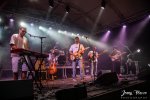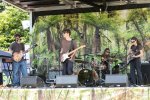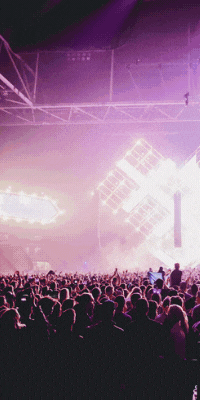2 a.m. Orchestra - Heads & Tails Single Video Review

A devil and an angel, one wonders as the black, devil tailed chap approaches the white, anthropomorphic bird dude. A tussle ensues and these enemies become a rotating yin-yang. After a revolution the yin-yang separates out again, and now our two protagonists are inverted, the black white and the white black.
No, I’m not talking about another lucid dream. This is the intro to the video for number two on the Kiwi FM Top Ten last week, 2 a.m. Orchestra’s new track Heads & Tails.
The intro is the tamest part. There are things falling into all kinds of holes, things morphing from one thing to another, often times it’s our devil friend and the angel chap turning into each other or intertwining again.
There’s the esoteric, hermetic, even Christian symbology, and sometimes it’s hard to determine to what extent the symbols are symbolic or whether these frantic morphings are the lunatic scribblings of an eccentric genius.
Did I mention the video was entirely hand drawn? And not especially well, a judgement I made on my first viewing. But in successive viewings I’ve changed my stance. I’ve seen past the scribble lines and fathomed the meaning behind them.
Think too, before judging, the seemly impossible task of hand drawing all those pictures using a mouse and what looks like Microsoft Paint. We’re talking 12 drawings per second, sixty seconds in a minute, three minutes and fifty seconds of music video. I’m no mathmagician, but that’s… a lot of… oh… wait… I have a calculator on my computer… who knew.
Right. 12*((60*3)+50)=more hand drawn pictures than I have words in this review. Close to ten times more, all done by 2 a.m. Orchestra mastermind, David Kelley. And the work paid off; the Heads & Tails video is floating all over the internet now and reaching nearly 13,000 views on Youtube. If you haven’t seen it, you can find it here: www.youtube.com/watch?v=Rq0kfg_aGLM
The music is very Radiohead, though still in the confines of Rock, and not deviating into the wilderness of post-Rock. Kelley’s voice is melodic, haunting, cracking into falsetto at the perfect moments, like someone who has spent a lot of time learning from Thom Yorke.
I’ll be reviewing the music in more detail when 2am Orchestra release their highly anticipated new album, Working to Divide, which you can preview here: http://youtu.be/0HAenYamrgk
About 2 a.m. Orchestra

After the release of Impermanence Kelley began travelling, living abroad and performing in various locations such as New York, Central America and even China. 2 a.m. Orchestra was put on the back-burner while Kelley toured with various projects: a country band that did shows for troops at international military bases, a theatre company performing a rock opera, and a percussion trio that gigged at state fairs. However, Kelley continued to write and record throughout this period. During two consecutive summers, the songwriter made a makeshift project studio from his grandmother’s country house located on the outskirts of his hometown (Fresno). These periods were spent compiling, writing, and recording a significant percentage of what now constitutes the entire 2 a.m. Orchestra catalogue (the vast majority of which remains unreleased).
Over the years, 2 a.m. Orchestra has primarily remained a solo endeavour – a one-man recording project with occasional outbursts of live performances. One such outburst occurred in 2008, a year after Kelley moved to Los Angeles. The L.A. band was a four-piece powerhouse with a turbo-charged rhythm section, gritty vocals, and surf-tone guitars. The band played sporadically, packing out indie venues like The Derby and Molly Malone’s.
Visit the muzic.net.nz Profile for 2 a.m. Orchestra
Releases
Other Reviews By Peter-James Dries
 AJA - Album Review: Kawai
AJA - Album Review: Kawai
13 Dec 2024 // by Peter-James Dries
Bilingual albums shouldn’t be special; they should be the norm. Or at least more common.
Read More...
 Ra Charmian - Album Review: Waiata Wairua
Ra Charmian - Album Review: Waiata Wairua
08 Oct 2024 // by Peter-James Dries
Waiata Wairua is an album that wouldn’t feel out of place performed in a late night jazz hall in some alternate history where the successes of the Maori battalion lead to a proliferation of Te Reo worldwide. The sort of interest that saw your dad singing in French in the 60's, when Mireille Mathieu was knocking about.
Read More...
 Ben Lloyd - Album Review: Leap of Faith
Ben Lloyd - Album Review: Leap of Faith
26 May 2024 // by Peter-James Dries
For over 30 years, this self-taught rocker from Mt Maunganui has been writing music. Now, for the first time since 2013, we finally get to hear his songs.
Read More...
 Yann Le Dorré - Album Review: The Circus is Closed
Yann Le Dorré - Album Review: The Circus is Closed
19 Dec 2023 // by Peter-James Dries
“We are Sex Bob-Omb and we're here to make you think about death and get sad and stuff!” - Scott Pilgrim vs.
Read More...
 Sanoi - Album Review: Echoes Of Home
Sanoi - Album Review: Echoes Of Home
25 Nov 2023 // by Peter-James Dries
Electronica offers no escapism for me. It’s more of what I already have.
Read More...
 Throng - EP Review: Decoherence
Throng - EP Review: Decoherence
20 Oct 2023 // by Peter-James Dries
You know that thing where the letter B has a personality, or words have textures and colours? That’s called synaesthesia.
Read More...
 Fortress Europe - Album Review: Old World
Fortress Europe - Album Review: Old World
10 Oct 2023 // by Peter-James Dries
Have you ever been torn between listening to Mozart or Periphery? Does Epica have too much of that darn singing for your tastes?
Read More...
 Yurt Party - Album Review: Yurt Party
Yurt Party - Album Review: Yurt Party
07 Sep 2023 // by Peter-James Dries
It sure isn't summer, and this is really not the Balkans, but Yurt Party’s new self-titled album refutes that. Back with another one of them Balkan rocking beats, Yurt Party’s debut is jazzy, erratic, and full of zest and energetic grooves, with flavour notes of ska, dub, and bergamot.
Read More...
Most Viewed Artists
Latest Galleries

Evan Rhys & the Stereo Streets @ Festival of Lights - Pukekura Park, New Plymouth - 18/01/2025
Midwave Breaks @ Festival of Lights - Pukekura Park, New Plymouth - 18/01/2025
Rumpus Machine @ Music in Parks, Aotea Square, Auckland - 18/01/2025
Fan Club @ Music in Parks, Aotea Square, Auckland - 18/01/2025
NZ Top 10 Singles
- APT.
ROSÉ And Bruno Mars - DIE WITH A SMILE
Lady Gaga And Bruno Mars - BIRDS OF A FEATHER
Billie Eilish - TASTE
Sabrina Carpenter - I LOVE YOU, I'M SORRY
Gracie Abrams - ESPRESSO
Sabrina Carpenter - SAILOR SONG
Gigi Perez - LOSE CONTROL
Teddy Swims - A BAR SONG (TIPSY)
Shaboozey - GOOD LUCK, BABE!
Chappell Roan










 Report A Problem
Report A Problem

